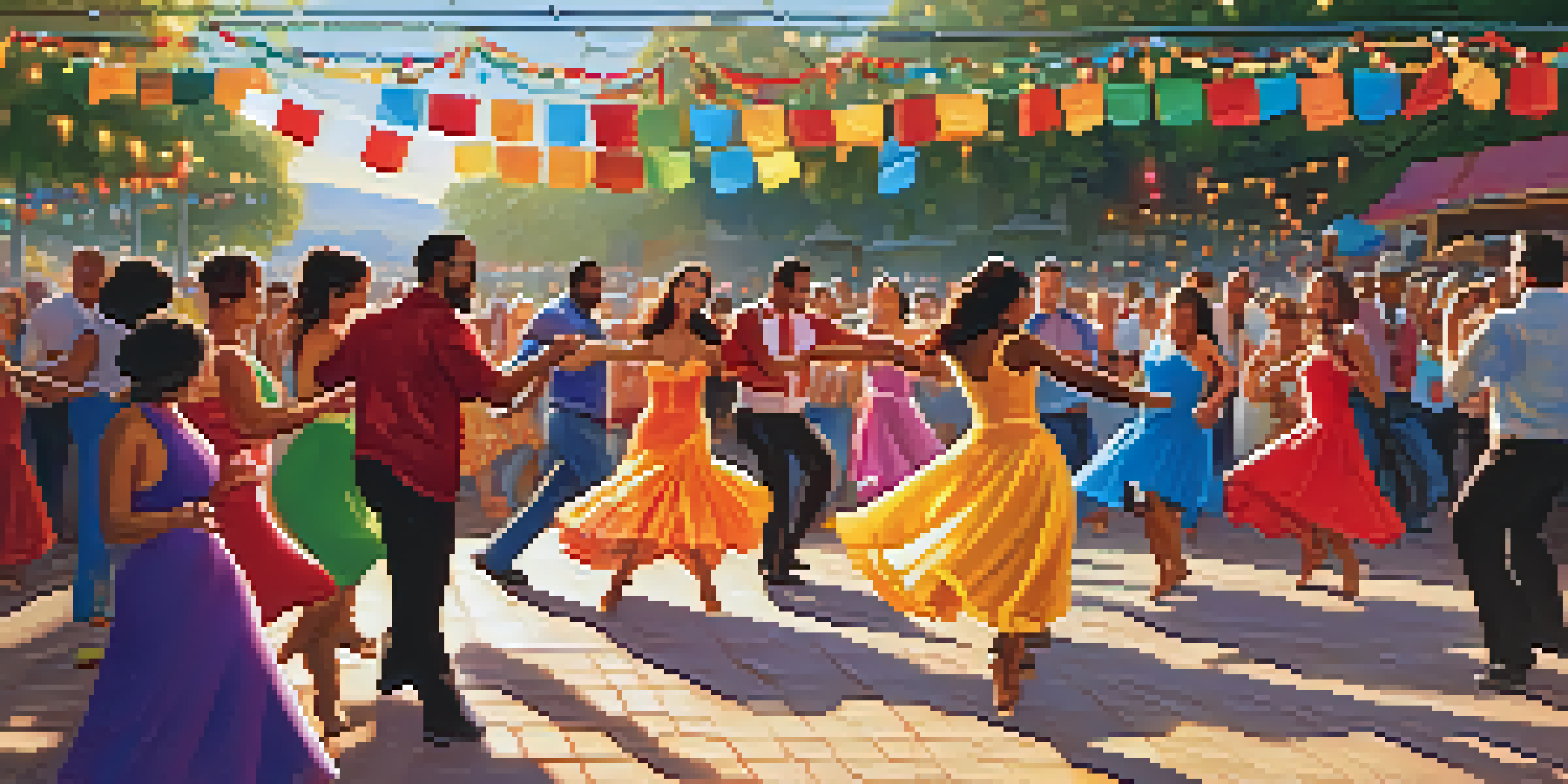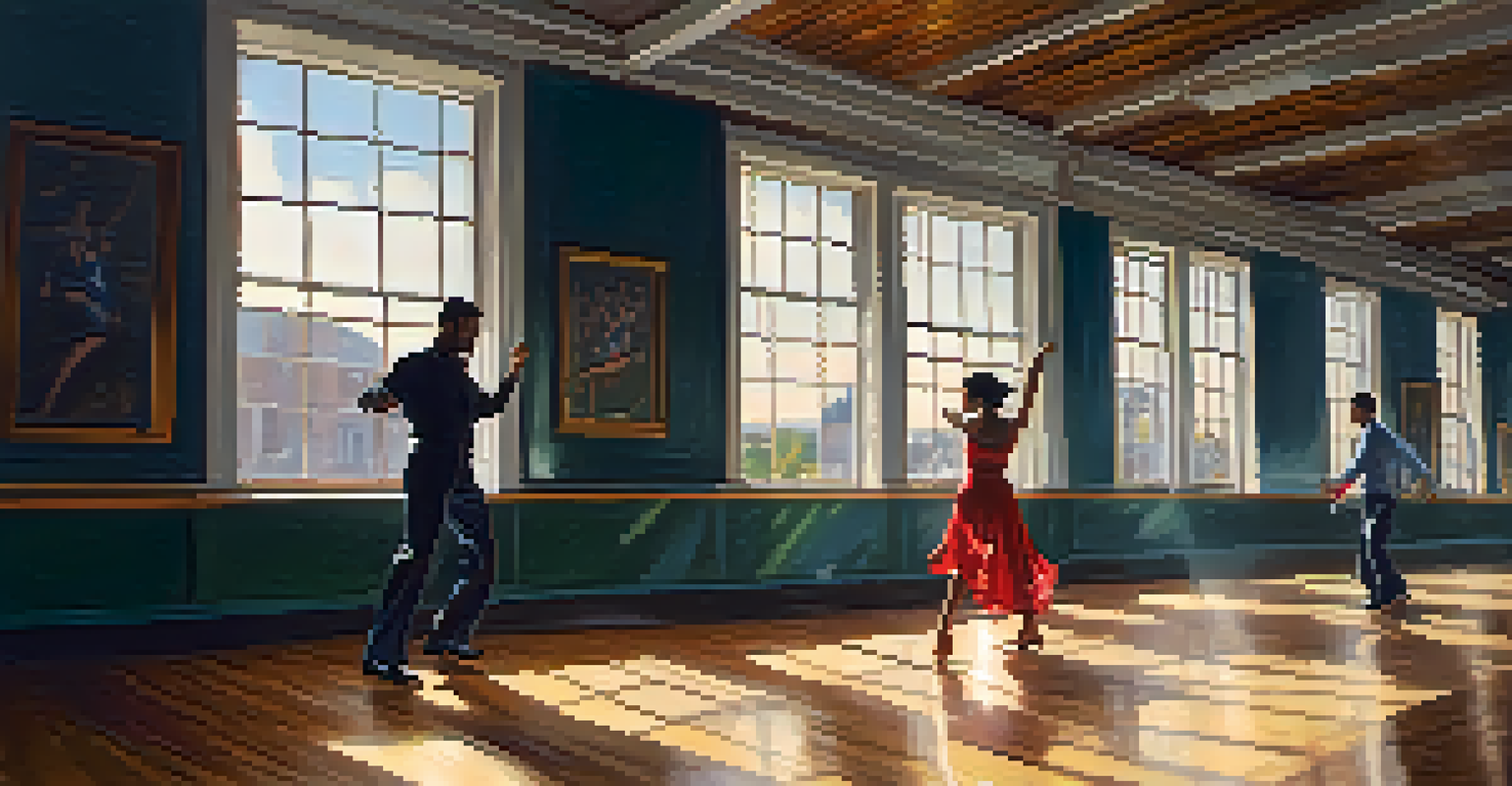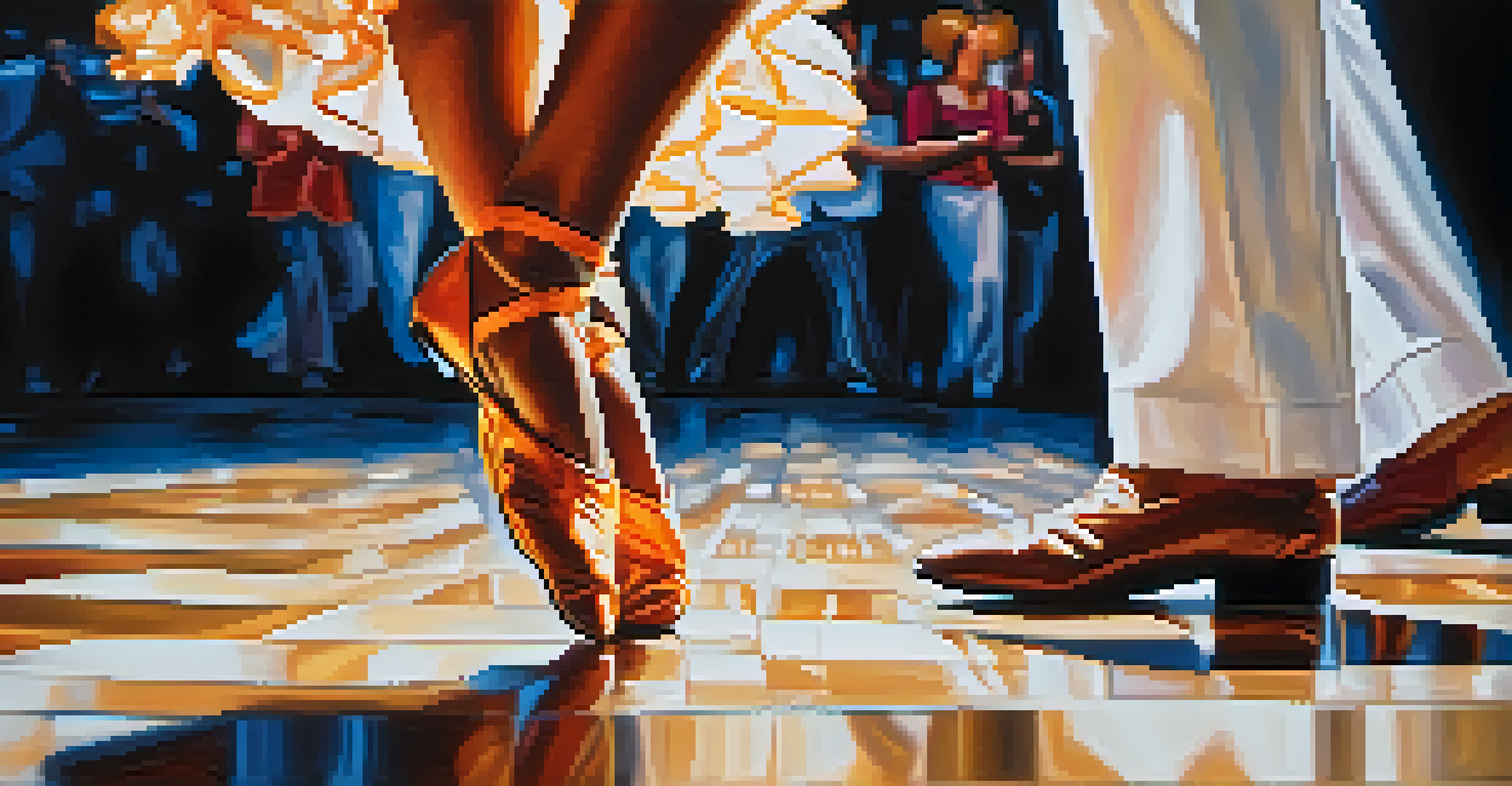The Global Spread of Salsa: A Dance of Cultural Fusion

The Origins of Salsa: A Melting Pot of Cultures
Salsa dance, often associated with vibrant Latin music, has roots that trace back to the Caribbean, particularly Cuba. It emerged as a dynamic blend of African, Spanish, and indigenous influences, showcasing the rich tapestry of cultures that coexisted in the region. This cultural fusion created a unique rhythm that invites dancers to express themselves freely, making salsa not just a dance but a celebration of diversity.
Salsa is a dance that brings together people from all walks of life, creating a vibrant tapestry of culture and connection.
As salsa spread from Cuba to the United States in the 1960s, it took on new forms and styles, reflecting the experiences of immigrant communities. New York City became a significant hub for salsa, where Puerto Rican and Cuban musicians infused traditional rhythms with jazz and funk. This evolution helped salsa thrive, creating a vibrant scene that attracted dancers and musicians from all backgrounds.
Today, salsa is a global phenomenon, transcending borders and uniting people through its infectious beats. The dance's ability to adapt and incorporate elements from various cultures is a testament to its universal appeal. As we explore salsa's journey, we see how it embodies not just a dance style but a cultural dialogue that continues to evolve.
Salsa's Journey: From the Streets of Havana to Global Stages
The journey of salsa is a fascinating one, moving from the intimate streets of Havana to grand stages around the world. Initially, salsa was a grassroots movement, rooted in social gatherings and local celebrations. People danced in backyards and community centers, sharing their stories through rhythm and movement, fostering a sense of belonging and joy.

As salsa gained popularity, it began to evolve into a more structured form, with dance schools and competitions emerging. Cities like Los Angeles and Miami became notable centers for salsa, each adding their unique flair. This regional variation enriched the dance, as different styles such as LA salsa and Cuban salsa showcased diverse interpretations of the same fundamental principles.
Salsa: A Cultural Fusion
Salsa dance originated from a blend of African, Spanish, and indigenous influences, showcasing the rich cultural diversity of the Caribbean.
Today, salsa festivals and dance congresses are held globally, attracting dancers of all skill levels. These events not only celebrate the dance but also foster connections among people from different cultures. This continuous exchange of ideas and techniques exemplifies how salsa remains a living, breathing art form.
The Role of Music in Salsa: A Heartbeat of Culture
At the heart of salsa is its music, a powerful fusion of rhythms that drives the dance. The infectious sounds of timbales, congas, trumpets, and pianos create a vibrant backdrop, inviting dancers to move instinctively. The lyrics often reflect themes of love, struggle, and celebration, resonating deeply with audiences and dancers alike.
Dance is the hidden language of the soul, and salsa allows us to express that language through rhythm and movement.
Salsa music has evolved over the decades, incorporating elements from genres like jazz, rock, and even hip-hop. This adaptability has helped it remain relevant and appealing to newer generations. The collaboration between musicians from various backgrounds further enriches the genre, showcasing the dance's spirit of cultural fusion.
As dancers interpret the music, they bring their own stories and emotions to the floor. This connection between music and movement is what makes salsa so captivating. It’s not just about the steps; it’s about feeling the rhythm and expressing oneself through dance.
Salsa Styles: Diversity in Motion
One of the most exciting aspects of salsa is its variety of styles, each reflecting its unique cultural heritage. From Cuban salsa, known for its circular movements and improvisation, to LA salsa, characterized by its flashy footwork and sharp lines, there’s a flavor for everyone. This diversity not only attracts different dancers but also enriches the overall salsa experience.
In addition, styles like Colombian salsa, known for its rapid footwork and lively energy, and New York salsa, which emphasizes intricate turns and patterns, demonstrate how regional influences shape the dance. Each style offers a fresh perspective, inviting dancers to explore and appreciate the nuances of salsa.
Diverse Salsa Styles
Salsa features various regional styles, such as Cuban and LA salsa, each reflecting unique cultural heritages and inviting creativity among dancers.
This variety fosters creativity and encourages dancers to experiment with their movements. As they learn different styles, they can incorporate elements from each into their own dancing, creating a personal expression that is as unique as they are.
Salsa Dance Communities: Building Connections
Salsa has a remarkable ability to bring people together, creating vibrant communities worldwide. Dance studios, social gatherings, and festivals serve as meeting points where individuals can share their passion for salsa. These spaces foster friendships and connections that often extend beyond dance, creating a sense of belonging and support.
In many cities, salsa nights at local clubs or community centers draw in dancers of all levels. Whether someone is a seasoned performer or a curious beginner, the welcoming atmosphere encourages participation and learning. It's not uncommon to see people from diverse backgrounds coming together to celebrate their love for this dance.
Moreover, salsa has become a powerful tool for cultural exchange. Dancers often travel to different countries to immerse themselves in local salsa scenes, learning new styles and forging connections. This cultural dialogue enriches the dance community, showcasing the unifying power of salsa.
The Impact of Technology on Salsa's Globalization
In today’s digital age, technology plays a significant role in the spread and evolution of salsa. Online platforms allow dancers to share tutorials, performances, and experiences, making it easier for enthusiasts to connect and learn from each other. Social media has also created a vibrant community where dancers can showcase their skills and inspire one another.
Streaming services have made salsa music more accessible, enabling listeners to discover new artists and styles. This exposure helps keep the genre alive and relevant, as new generations of dancers are introduced to its rich history and diverse sounds. Additionally, virtual dance classes have emerged, allowing anyone, anywhere, to learn salsa from the comfort of their home.
Community and Connection
Salsa creates vibrant communities worldwide, fostering connections through social gatherings, clubs, and festivals, while promoting cultural exchange.
These technological advancements have not only expanded the reach of salsa but also transformed the way people engage with the dance. As we continue to navigate the digital landscape, salsa evolves, reflecting the changing times while remaining true to its cultural roots.
The Future of Salsa: A Dance Without Borders
Looking ahead, the future of salsa appears bright, with its global reach expanding further. As new generations embrace the dance, they bring fresh ideas and influences that will shape its evolution. This continuous cycle of innovation ensures that salsa remains dynamic and relevant, appealing to both seasoned dancers and newcomers alike.
Moreover, the fusion of salsa with other dance styles and genres will likely continue, creating exciting hybrid forms that push the boundaries of traditional salsa. Collaborations between dancers from different backgrounds can lead to unique performances that celebrate diversity while staying true to the essence of salsa.

Ultimately, salsa's ability to adapt and thrive in a globalized world speaks to its universal language of rhythm and movement. As it continues to break down cultural barriers, salsa remains a powerful testament to the beauty of cultural fusion, inviting everyone to join the dance.